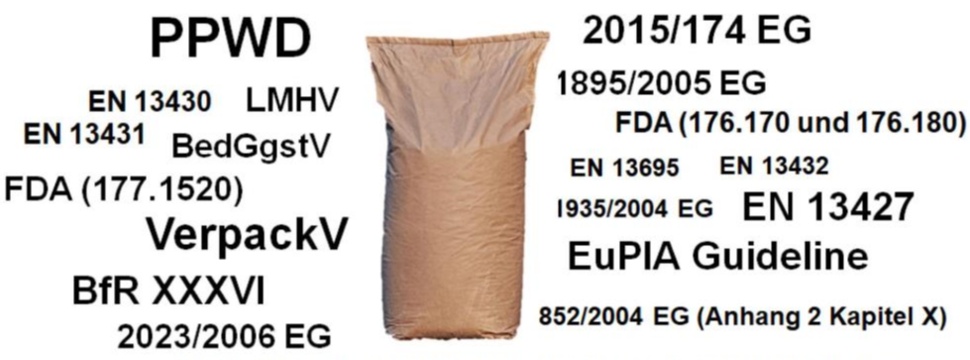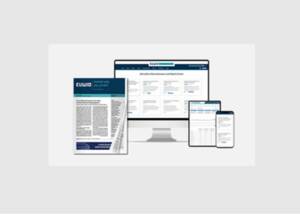Paper sack complies with ever-increasing number of regulations - Conformity with legal requirements
News General news
Packaging is subject to a large number of legal guidelines and regulations. And new ones are being added all the time. This also applies to the paper sack. German paper sack manufacturers deal with the growing requirements on a daily basis in order to be able to offer their customers safe and legally compliant packaging not only today, but also in the future.

To ensure the safe use of a packaging, the legislator specifies various guidelines. The paper sack is subject to both packaging-specific and application-related regulatory requirements. The Packaging and Packaging Waste Directive (PPWD), which is expected to be replaced by the European regulation of the same name in 2024, is the overarching directive. Until then, large parts of this European directive will be transposed into national law by the individual states. In Germany, this is done, among other things, through the German Packaging Act. In some countries, additional packaging-specific regulations also apply. In addition, different guidelines apply depending on which product is filled into a bag. The guidelines on Good Manufacturing Practice (GMP) apply to various manufacturing products such as medicinal products and their active ingredients as well as foodstuffs. In addition, it provides manufacturers with a process that defines the quality assurance of all production processes and accompanying safety measures. This must not only be adhered to, but also comprehensively documented.
Dealing with regulations in practice
And what does ensuring compliance with the law look like in practice? In the first step, the customer states his requirements for the packaging. The paper bag manufacturer checks whether he can meet the specifications and confirms the delivery item. For each individual specification, he must provide the customer with a supplier document that proves the safety of the respective packaging material based on the applicable regulations and processes - from the paper to the adhesive. "In the maze of ordinances and regulations, it is easy to lose track of everything," says Karsten Hunger, Managing Director of the Gemeinschaft Papiersackindustrie e.V. (GemPSI). "The German paper sack industry supports its customers and suppliers in the best possible way with its comprehensive know-how and conscientious quality assurance and documentation with regard to regulations."
Particularly strictly regulated: Paper bags for food
Paper sacks for food are subject to what are probably the most extensive legal requirements in terms of safety and hygiene. All materials used in the paper sack must be suitable for food contact and documented as such - from paper to barrier layers to adhesives and printing inks. Furthermore, the regulations differ depending on the type of food, conditions of use, storage duration and temperature. One of the most important regulations is the Framework Regulation (EC) No. 1935/2004, which lays down general principles for food contact materials. In addition, there are numerous regulations, among others concerning manufacturing practices (2023/2006), paper (Recommendation XXXVI of the Federal Institute for Risk Assessment, BfR) and for materials made of plastic (10/2011). A comprehensive overview of all relevant national and European regulations and procedures required to collect, evaluate and document all necessary information is provided by the European Paper Sack Research Group (ESG) Guide for Paper Packaging with Food Contact . "The German paper sack industry ensures optimum protection of the food to be packaged with careful material selection, strict quality assurance and complete traceability," says Hunger. "It also ensures that all formalities for conformity with the legal requirements for food contact are complied with."
Correct labelling for packaging for dangerous goods
Dangerous goods are also subject to stringent packaging requirements by law. All substances that are considered dangerous goods are assigned UN numbers that are valid worldwide. The paper sack manufacturer uses these to determine which regulations apply to packaging and transport. The Federal Office for Materials Research and Testing (BAM) decides whether a particular paper sack is approved as dangerous goods packaging. "The basis for this is a special test procedure to which the sack is regularly subjected," explains Achim Gottmann, quality manager at a GemPSI member company. "Each approved packaging receives a special marking." The UN test number informs about contents and packaging, hazardous substance symbols about dangers that can emanate from a product. A special feature: officially approved dangerous goods packaging is subject to extended product liability. From filling to transport to storage, the manufacturer is liable for its packaging.
Bureaucratic effort increases
The more regulations are in force for the packaging of a certain product, the more time is needed to document legal compliance. But non-specific customer requirements can also delay the process. "Many of our customers have switched to issuing standardised lists of requirements through purchasing. These can be used for orders of any kind, whether paper clips, work clothes or paper bags," Gottmann reports. "Many suppliers feel overwhelmed by these page-long lists. Because it is not clear from them which of the requirements they have to fulfil." In addition, there are fillers who distribute their products throughout Europe. Although the paper sack is actually intended for a few markets, they demand that it can potentially be used in more countries. Since different guidelines may apply in different countries, this requirement also complicates the documentation. It becomes particularly complicated when a country rushes ahead with a regulation that has not been adopted at EU level. This happened in France, for example, with the ban on mineral oils in printing inks. "Our customers then requested corresponding certificates proving that our printing inks are mineral oil-free," says Gottmann. "Since no such certification has yet been established at EU level, we are unable to issue such a certificate. This means we meet with a lack of understanding from customers." In such cases, the bureaucratic effort is hardly manageable for small and medium-sized paper bag manufacturers. "We would like to plead for keeping the effort as low as possible for all parties involved," says Hunger. "As an association, we are therefore in favour of Europe-wide regulations. In cooperation with our European umbrella organisation EUROSAC, we are continuously sounding out possible changes in the law so that our members can respond flexibly to short-term regulations."
Farsightedness and flexibility required
Flexibility is also required in the long term, because the German paper sack industry assumes that regulations for packaging will become even more complex in the future. Sustainability and corresponding certifications will be one of the challenging issues of the future. One example is inconsistent disposal systems for packaging in European countries, which hinder the single European market through national labelling regulations (e.g. Triman in France). In addition, regulatory conflicts of objectives arise. For example, all current and planned legislation calls for the increased use of recycled material. However, a recycled content in paper often requires the use of barriers in contact-sensitive areas such as food contact. In some cases, these can make the required recyclability of the paper bag more difficult. In addition, when recycled material is used, more material is needed to achieve the same tear strength. This in turn runs counter to resource efficiency. "What is needed is packaging that is as resource-efficient as possible, uses as little material as possible and offers the greatest possible safety, including food contact," says Hunger. "A lot of research is currently being done in this area. Our goal is to be able to offer our customers safe packaging that meets all regulations in the future as well. That's why we are constantly expanding our expertise and acting with foresight and flexibility in response to short- and long-term trends and developments."










